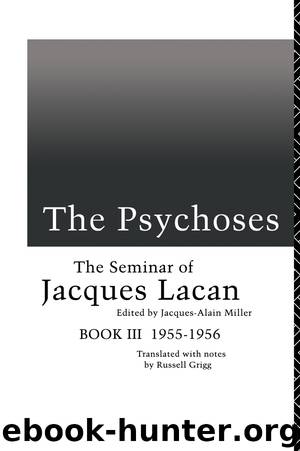The Psychoses by Lacan Jacques Miller Jacques-Alain

Author:Lacan, Jacques, Miller, Jacques-Alain
Language: eng
Format: epub
Publisher: Taylor and Francis
1 In English in the original.
2 Michael Josef Eisler, “Analyse eines Zwangssymptoms”
XIII
The hysteric’s question (II): What is a woman?
Dora and the Feminine Organ the Signifying Disymmetry the Symbolic and Procreation Freud and the Signifier
What was the meaning of my lecture last night on the training of analysts? It was that it is essential to carefully distinguish between symbolism properly so-called, that is, symbolism as structured in language, that in which we understand one another here, and natural symbolism. I have summed this up in the expression, To read coffee grounds is not to read hieroglyphics.
For the audience that it was, it was necessary to bring the difference between signifier and signified to life a bit. I gave examples, some of them humorous, I gave the schema, and I went on to some applications. I reminded them that analysts’ practice makes them fascinated by highly seductive imaginary forms, by the imaginary meaning of the subjective world, whereas what one needs to know – this is what interested Freud – is what organizes this world and enables it to be displaced. I pointed out that the dynamics of phenomena in the analytic field are linked to the duality that results from the distinction between the signifier and the signified.
It’s no accident that it was a Jungian who brought in the term symbol. At the heart of the Jungian myth the symbol is effectively thought of as a flower that rises up from the depths, a blossoming of what lies in the depths of man qua typical. The question is whether this is what a symbol is, or whether on the contrary it’s something that envelops and forms what my interlocutor nicely called creation.
The second part of my lecture concerned the consequences in analysis of forgetting the signifier-signified structuration. And there I was only able to give an indication of the way in which the theory of the ego currently being promoted in New York circles completely changes the perspective from which the analytic phenomena have to be approached, and that it is party to the same effacement. This effectively ends up placing the ego-to-ego relation in the foreground. And a simple inspection of Freud’s articles between 1922 and 1924 shows that the ego is nothing like what it’s currently made out to be in analytic usage.
Download
This site does not store any files on its server. We only index and link to content provided by other sites. Please contact the content providers to delete copyright contents if any and email us, we'll remove relevant links or contents immediately.
Periodization Training for Sports by Tudor Bompa(8210)
Why We Sleep: Unlocking the Power of Sleep and Dreams by Matthew Walker(6655)
Paper Towns by Green John(5138)
The Immortal Life of Henrietta Lacks by Rebecca Skloot(4550)
The Sports Rules Book by Human Kinetics(4342)
Dynamic Alignment Through Imagery by Eric Franklin(4176)
ACSM's Complete Guide to Fitness & Health by ACSM(4019)
Kaplan MCAT Organic Chemistry Review: Created for MCAT 2015 (Kaplan Test Prep) by Kaplan(3970)
Introduction to Kinesiology by Shirl J. Hoffman(3743)
Livewired by David Eagleman(3729)
The Death of the Heart by Elizabeth Bowen(3578)
The River of Consciousness by Oliver Sacks(3572)
Alchemy and Alchemists by C. J. S. Thompson(3481)
Bad Pharma by Ben Goldacre(3396)
Descartes' Error by Antonio Damasio(3248)
The Emperor of All Maladies: A Biography of Cancer by Siddhartha Mukherjee(3112)
The Gene: An Intimate History by Siddhartha Mukherjee(3074)
The Fate of Rome: Climate, Disease, and the End of an Empire (The Princeton History of the Ancient World) by Kyle Harper(3032)
Kaplan MCAT Behavioral Sciences Review: Created for MCAT 2015 (Kaplan Test Prep) by Kaplan(2957)
